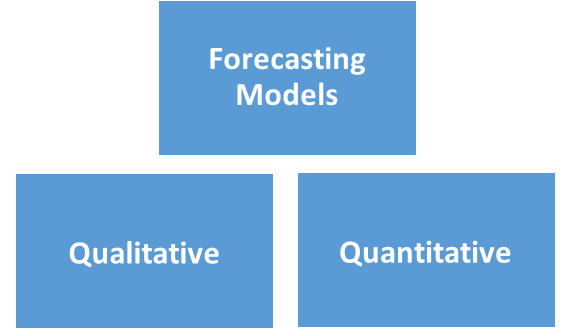
 Data Structure
Data Structure Networking
Networking RDBMS
RDBMS Operating System
Operating System Java
Java MS Excel
MS Excel iOS
iOS HTML
HTML CSS
CSS Android
Android Python
Python C Programming
C Programming C++
C++ C#
C# MongoDB
MongoDB MySQL
MySQL Javascript
Javascript PHP
PHPPhysics
Chemistry
Biology
Mathematics
English
Economics
Psychology
Social Studies
Fashion Studies
Legal Studies
- Selected Reading
- UPSC IAS Exams Notes
- Developer's Best Practices
- Questions and Answers
- Effective Resume Writing
- HR Interview Questions
- Computer Glossary
- Who is Who
Forecasting Models Used in Operations Management
Introduction
Forecasting in operations management is the systematic technique used to predict future outcomes based on historical data. Business forecasts are a necessity for productively planning the operations of a company. Forecasting the required raw materials, workforce capacity, and energy requirement along with other requisites are essential for the smooth functioning of operations management. Various methods and techniques and different types of forecasting are put to use in organizations based on their requirement and resultant outcomes. An elucidation of the variety of forecasts used in operations management and its implementation is brought out here.
Forecasting Models in Operations Management
Forecasting in operations management is carried out based on the size, available information about the company and business goals. As the concept of forecasting is about making intelligent assumptions by predicting the future and facilitate planning, proper and scientific models and methods should be adopted to forecast the outcome.
Different models of forecasting are as discussed below.

Qualitative
Judgmental − This type of forecasting relies on judgments from subject matter experts of the concerned area or department. It is easy to implement too.
Delphi − Here inputs are taken collectively from management, employees and end users. Every stake holder gets a chance to provide input.
Sales force composite − This method uses predicting future demand by summing up the opinion of each sales person about the sales target expected to achieve in respective territories.
Market Survey − This approach seeks inputs from past customer data and potential clients about their purchase plans in future. Marketing personnel are often given the task to gather such information as they are the first line of customer contact. Material procurement staff who are in contact with the suppliers can also be used to collect market intelligence report of competitors who plan innovative projects or technologies
However, this type of forecasting is not free from judgmental bias.
Quantitative
Time series − This is quantitative techniques that uses previous data for future predictions. These types of forecasts are usually done to develop long term forecasts as they rely on historic patterns that relate to a specific period. Analysing monthly sales over a period of ten years is an example.
Associative models − These models involve statistical analysis to forecast. Regression analysis is mostly used in this type of models to find the relation and effect between two factors. Marketing infrastructure in relation to sales is an
Yet another type of forecasting technique is also used where predictions are done over different range of time.
Short − These are forecasts made for shorter periods usually for 3 months forward. They are commonly used for recruitment projections, schedules and deciding production levels.
Medium − This ranges from 3 months to a year into the future. Budgeting forecasts, sales projections and demand planning are carried out in medium range forecast.
Long − Big budget forecasts made towards capital expenditures, relocation or expansion, and innovations come under long term forecasting. These are typically performed for more than 3 years.
Types of Forecasting Methods in Operations Management
Deriving from the above models, operations management use the following types of forecasts based on the requirement specific to each organization.
Run Rate Forecasting Method
This forecasting type in most commonly used method in operations management. The past data patterns are used to predict demand patterns, predict resource availability based of historic trends and graph of financial requirements at each stages of business process.
Driver-based Method
These are based on key process metrics of operations to predict output. Factors that respond in relation to a change in another is predicted here. Capacity to meet market demands based on the rate of production is an example.
Risk-based Method
Unforeseen risks could stall the business operations and result in loss. Forecasting risks and planning accordingly is the best way to overcome business risks. Assessment and prediction of possible risks including strikes, machine downtime and cost overrun can be mitigated or reduced if measures to be taken are planned ahead. Keeping constant communication with the workforce, ensuring regular maintenance of production equipment and judicious monitoring of operating costs could be initiated based on predictions from risk-based forecasting method.
Using one or more of the above-mentioned methods, these are the two most important metrics which you might want to consider for forecasting to ensure a seamless production process.
Scheduling − Staff and inventory scheduling are critical functions to meet demand. This process involves organizing, selecting, and allocating the necessary resources to complete the desired outputs over a period of time. In a service business, for example, you can use a forecast to ensure there are enough front office employees to meet the fluctuating demand that often involves attending to immediate customer service requests.
Material requirements planning (MRP) − This system is used to calculate the materials needed to manufacture a final product. MRP requires you to manage inventory, determine if any additional materials are needed, and schedule production.
Utilizing one or more types of forecasting based on the business requirement is critical to ensure smooth and seamless operational functions.
How to Implement Forecasting in Operations Management?
Forecasts are to be done accurately for successful implementation and develop plans. The following principles need to be recognised while implementing forecasts in operations management.
Short-term forecasts for higher accuracy − Short-term forecasts uses quantitative data that gives better accuracy than making long term predictions. Hence it is always productive to focus on short-term forecasts on a regular basis.
Acceptance of marginal level of error − Prediction is foreseeing future and hence there is always a chance of error. All plans based on forecasts must be made taking this fact into account and acknowledging space for error.
Choose aggregate forecasts − Statistically, a comprehensive data set gives more accurate analysis. Forecasting sales for an entire state or territory will provide a more accurate result than for a single store.
Avoid complex forecasts − It is always advisable to stick to simple and short forecasts for better accuracy and usability.
Leveraging technology − As in any other business activity integrating technology to forecasting methods not only enable ease of operations and reduce costs but also enhances precision in business forecasts. AI enabled software like predictive analytics can be used to project complex data that can give a more accurate and better forecast for operations management.
Conclusion
To conclude, it can be observed that informed predictions can help an organization to waive off anticipated risk. Forecasting predicts a future outcome and hence possesses a critical role in the operations management of businesses today. It serves as a solid aid to the process of planning. Lack of forecasting or inefficient forecasting methods can result in failure of the business plan. It is rather a systematic way to anticipate future with the help of inferences made from existing and previous data.
The various models and types of forecasts applied to operations management and constructive ways of implementing it are described here. Business organizations use these different types of forecasting based on its scope, accuracy and anticipated outcome. It facilitates stress free infrastructure commitments by assuring profit in the long run. It also helps to forecast future demands and thus enhances the scope for innovation and develop new products.

